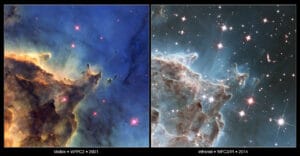
This image compares two views of the same detailed area in the star-forming nebula NGC 2174 from the Hubble Space Telescope. On the left is a visible-light image made by WFPC2 observations taken in 2001 — and released in 2011 — and on the right is an image made by the WFC3 infrared camera. Infrared light penetrates more dust and gas than visible light, allowing details to become visible. A jet of material from a newly forming star is visible in one of the pillars, just above and left of centre in the right-hand image. Several galaxies are seen in the infrared view, much more distant than the columns of dust and gas.
RSVP HERE TO GET ZOOM DETAILS: https://marylandnature.wildapricot.org/event-4520317
Most objects in space give off several types of electromagnetic radiation at the same time. Even though you can’t see them with your eyes, they are there, and we use different instruments to make them visible. James Webb Space Telescope’s infrared “eyes” will help us see farther and deeper than ever before facilitating the study of the early universe and the formation of galaxies, stars and planets.
In part two of the James Webb Experience, Dr. Stephanie LaMassa from the Space Telescope Science Institute will help us understand infrared light, why it is important for learning about the early universe, how the Webb observes infrared light, and the technical challenges with observing infrared – especially keeping the infrared detectors cold enough to function (40 kelvin or -388 degrees Fahrenheit)
Dr. Stephanie LaMassa is a Scientist at the Space Telescope Science Institute and serves as the manager of the JWST NIRISS instrument team. Steph studies the growth and evolution of growing supermassive black holes (i.e., active galactic nuclei) and the interplay between black hole fueling and star formation from a multi-wavelength perspective. Steph is also interested in understanding how highly variable active galactic nuclei provide insight into the feeding habits of black holes and the lifetimes of these systems.
RSVP HERE TO GET ZOOM DETAILS: https://marylandnature.wildapricot.org/event-4520317
